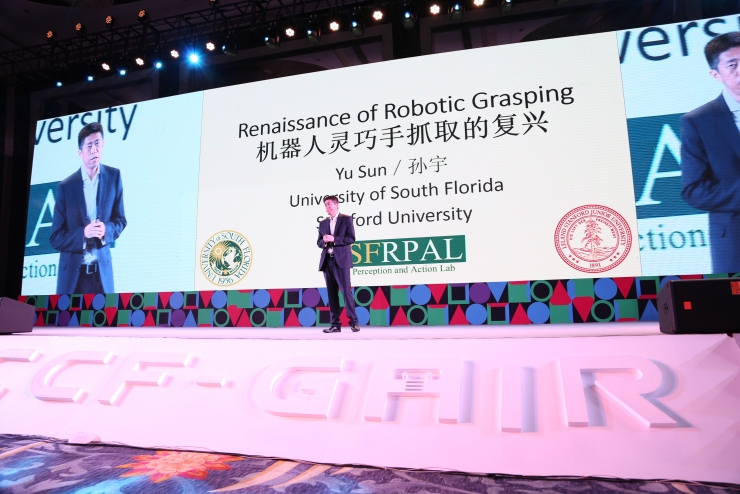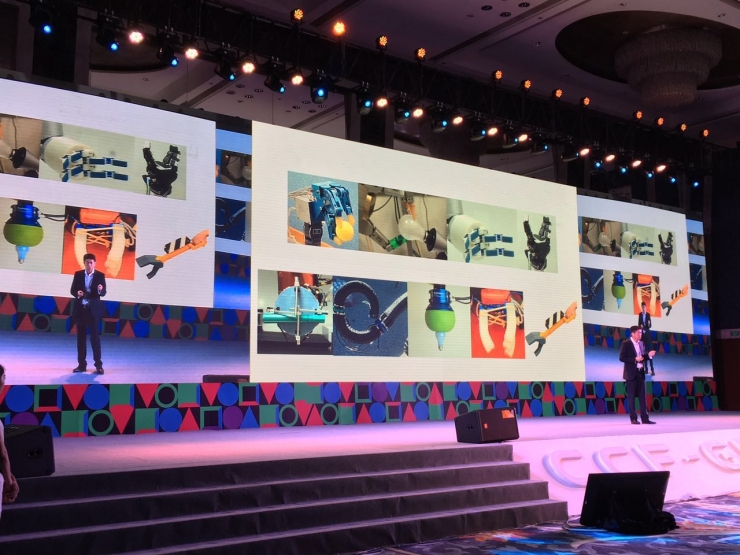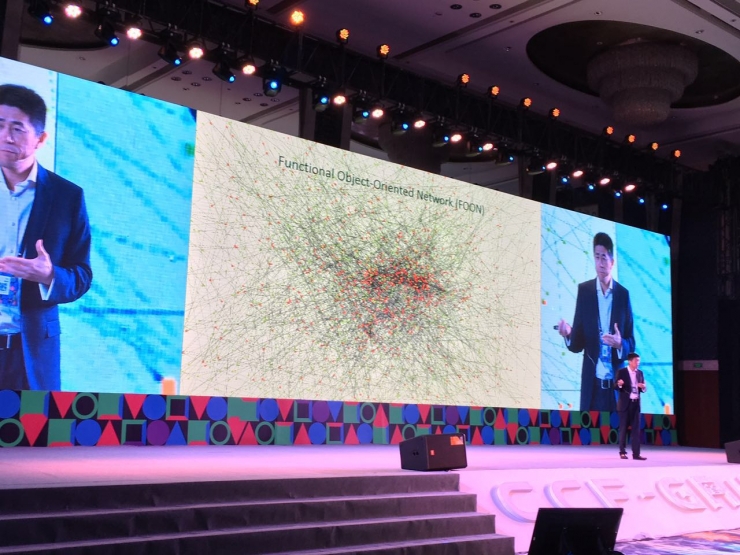
At the CCF-GAIR Summit "Robots and the Future" on August 13th, Prof. Yu Sun from the University of South Florida Department of Computer Science delivered a speech on smart robotic hands.
Sun Yu is also the visiting chairman of the Stanford University and the founding chairman of the IEEE RAS Robotics Arming and Operations Technical Committee. He is also currently advising the President of the United States Presidential State Advisory Committee on robotics.
In the speech, Prof. Yu Yu said that humanoid robots are very precise and cool, but the common feature is the high cost, the cheapest 30,000 pounds, and the most expensive ones are hundreds of thousands of dollars. However, if robots are to be applied to the lives of ordinary people and achieve industrialization and commercialization, then they need to find new ways.
Prof. Yu Yu then introduced some "robots" that are not like human hands. They have different shapes, but they can be applied to various scenes of human life.

Professor Sun Yu uses his academic enlightenment film "Terminator" as an example. The "Terminator Robot" includes two core components: robots and smart chips. Another major task of his University of South Florida RPAL laboratory is to use deep learning to build a knowledge base called “Functional Object-Oriented Network†(FOON). This knowledge base is mainly used by computers. Online video learning. Through this knowledge base, robots learn how to use different functions when facing different items in daily life.

Lastly, Prof. Sun Yu ended the Trump quote and encouraged everyone to “Make Grasping Great Againâ€.
The following is a record of Prof. Yu Yu’s speech. In order to provide the reader with the freshest news, the following manuscripts have not been compiled. Later, Lei Feng.com (search “Lei Feng Network†public number attention) will offer more detailed content. Â
Sun Yu:
I am very happy to discuss with you the development of the robot hand. Can anyone in this room win the IBM Deep Blue calculation in chess? Who can win Google Alpha Dog in Go? Robots have surpassed people in some areas, but robots do not have smart hands. The question now is how can we give the robot a smart hand.
In the Renaissance of the early 19th century, many scientists and artists began to study the human body itself, including the famous Leonardo da Vinci who began to study the anatomical structure of the human body. Leonardo da Vinci was also very interested in human hands. After studying the manpower, Da Vinci was shocked by the complex functions of manpower. Because our hands only account for 1% of our weight, we have 1/4 of our body's 206 bones in our hands. Our hands are very complex mechanical structures and may be the most complex mechanical structures in the human body.
In 1993, I saw a film "Terminator 2". I was very surprised at what the robot in the movie could do. In this movie, robots and smart chips are considered to be the two most important technologies used to produce Terminator robots. In the film, the heroic character and his mother want to destroy these two core technologies (robots and smart chips) while killing the professor who developed the two technologies.
After watching this movie, I did not worry about the future of human beings. Instead, I thought that robots were very good in my mind, and I was particularly interested in the dexterity of robotic hands. At that time, my dream was decided. My dream was to create the first Terminator-like robot like the professor in the movie. So I took this dream to study in the United States and entered the laboratory of MIT. When I entered the lab, my dream was destroyed. Why? Because I saw this robot named "Utah/MIT", my teacher realized my dream a long time ago, 10 years earlier than when I watched the "Terminator 2" movie. Slowly I learned about its history. It was actually created by two geniuses.
After 1983, there were a great variety of humanoid robots. Here, I listed four items. All of them are very representative. The first is the DNR of Germany and the humanoid robot of HIT Group. The two are NASA's robots, the third is the latest, and the fourth is more cool. These robots, like Swiss watches, are very elaborate in design, and mechanical parts are precisely meshed. Each has a dozen degrees of freedom and many joints. At the same time, they also have a common characteristic. Their cost is very expensive, and the most expensive is more than 100,000 US dollars. These robots have been demonstrated in many laboratories. They can do a lot of things. Just now, everyone has seen videos of some robots. They can do a lot of things like manpower, cooking, housework, and daily life.
Actually, all of the robots you see in the video are mostly organized and directed carefully. Through very complicated programming, it takes a long time for these demos to be able to work in specific environments and sports. achieve. They are still far from being able to apply in complex environments.
The robots we just saw are very cool, but they are rarely seen in real life in large-scale applications, not only because of the high cost, but because of the complex application environment. We use engineering methods to solve the problems of engineering. We have some needs that can be simplified into projects. Through these needs, we can find solutions to projects. Hollywood believes that our idea is feasible. They have a movie called WALL-E. The robot's hand in this movie is not similar to the human hand. It has three fingers and is very different from human fingers. The WALL-E can do a lot of things. At least it can change the light bulb inside the cartoon. Actually, the first step of complicated programming is not a manipulator-like robot, but a three-fingered robotic man. Starting from this field, because of various engineering reasons and various problems, we You can see there are many different engineering solutions.
In fact, we already have many solutions in the industry, and there is no need to use robots for crawling. This is the robot champion of the previous year and did not use robots to defeat other teams with vacuum suction technology. In this environment, American scholars believe that the problem of "grabbing objects" has been solved, but "crawlers and use tools" have not yet been resolved. So, the biggest remaining problem is machine intelligence. We lack smart chips.
With the development of science and technology, Hollywood has followed up. There is a smart center in its movie. We now actually have many such smart centers, including Google's smart center. In our laboratory, we invented a "Functional Object-Oriented Network" (FOON), which uses a variety of objects and its functions and operations to create a network knowledge base. I will demonstrate how this network is built. This network looks at the online video. For example, knowing how to do something, put this demo on the Internet, and through processing, based on this video, figure out how this thing is done. What, what action was used to build a network is equivalent to a knowledge network. After this knowledge network is combined, a large knowledge base will be established. We can obtain the desired information by searching the knowledge base. For example, today you want to eat grilled steak in the evening, tell the robot, the robot will come to this network to inquire, after the query will get a map, this map includes what raw materials, what steps are needed, the basic elements of the entire screen include objects and movement.
When the robot performs a specific task, many operations have real contact with other objects, such as screwing things, and contact with a screwdriver (the robot is subjected to different forces during the screwing process). The same object, to do different movements, also needs different forces and positions, and different grasping postures are needed when grasping.
What we do is to summarize different requirements according to different tasks, and get the best solution based on this requirement. For example, as a hammer, the trajectory is settled. What needs to be done is how to make the robot move less. In this picture, when gripping, the robot must ensure that the mouse does not fall out during the movement. Another example of screwing the bulb is when the bulb is screwed. The bulb is actually in contact with the lamp holder (different forces are generated in the process). .
Personally, I think that robot intelligence and computer intelligence are two different concepts.
Because robots have real contact with the natural environment, this is a very big problem and it is a problem that general computer intelligence has not yet addressed. We will hold a grab competition in South Korea in October this year. There are many prizes here and I hope everyone will form a team to attend. We have published nine tasks here, all of which are tasks that robots are actually in contact with the physical environment. Lastly, Trump's famous quote, Make Grasping Great Again, hopes everyone will better care about robot dexterous hand grabbing.
Fastener is a kind of mechanical parts used for fastening connection and widely used.A wide variety fasteners of Screw Bolt nut can be found on all kinds of achinery,equipment,vehicles,ships,railways,bridges,building,structures,tools,instruments,meters and supplies.It is characterized by a variety of specifications,performance and use of different and standardization,serialization,generalization of the species is also very high.Therefore,some people have national standard fasteners called standard fasteners or referred to as standard parts.
Hardware Fastener,Stainless Steel Fastener,Screw Fastener,Female Fastener,China Fastener
BAODING JIMAOTONG IMPORT AND EXPORT CO., LTD , https://www.chinagroundscrew.com